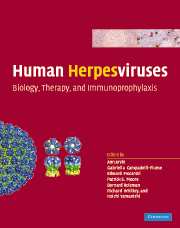Book contents
- Frontmatter
- Contents
- List of contributors
- Preface
- Part I Introduction: definition and classification of the human herpesviruses
- Part II Basic virology and viral gene effects on host cell functions: alphaherpesviruses
- Part II Basic virology and viral gene effects on host cell functions: betaherpesviruses
- Part II Basic virology and viral gene effects on host cell functions: gammaherpesviruses
- Part III Pathogenesis, clinical disease, host response, and epidemiology: HSV-1 and HSV-2
- Part III Pathogenesis, clinical disease, host response, and epidemiology: VZU
- Part III Pathogenesis, clinical disease, host response, and epidemiology: HCMV
- Part III Pathogenesis, clinical disease, host response, and epidemiology: HHV- 6A, 6B, and 7
- Part III Pathogenesis, clinical disease, host response, and epidemiology: gammaherpesviruses
- Part IV Non-human primate herpesviruses
- Part V Subversion of adaptive immunity
- Part VI Antiviral therapy
- Part VII Vaccines and immunothgerapy
- 69 Herpes simplex vaccines
- 70 Varicella-zoster vaccine
- 71 Human cytomegalovirus vaccines
- 72 Epstein–Barr virus vaccines
- 73 DNA vaccines for humanherpesviruses
- 74 Adoptive immunotherapy for herpesviruses
- 75 Immunotherapy of HSV infections – antibody delivery
- Part VIII Herpes as therapeutic agents
- Index
- Plate section
- References
69 - Herpes simplex vaccines
from Part VII - Vaccines and immunothgerapy
Published online by Cambridge University Press: 24 December 2009
- Frontmatter
- Contents
- List of contributors
- Preface
- Part I Introduction: definition and classification of the human herpesviruses
- Part II Basic virology and viral gene effects on host cell functions: alphaherpesviruses
- Part II Basic virology and viral gene effects on host cell functions: betaherpesviruses
- Part II Basic virology and viral gene effects on host cell functions: gammaherpesviruses
- Part III Pathogenesis, clinical disease, host response, and epidemiology: HSV-1 and HSV-2
- Part III Pathogenesis, clinical disease, host response, and epidemiology: VZU
- Part III Pathogenesis, clinical disease, host response, and epidemiology: HCMV
- Part III Pathogenesis, clinical disease, host response, and epidemiology: HHV- 6A, 6B, and 7
- Part III Pathogenesis, clinical disease, host response, and epidemiology: gammaherpesviruses
- Part IV Non-human primate herpesviruses
- Part V Subversion of adaptive immunity
- Part VI Antiviral therapy
- Part VII Vaccines and immunothgerapy
- 69 Herpes simplex vaccines
- 70 Varicella-zoster vaccine
- 71 Human cytomegalovirus vaccines
- 72 Epstein–Barr virus vaccines
- 73 DNA vaccines for humanherpesviruses
- 74 Adoptive immunotherapy for herpesviruses
- 75 Immunotherapy of HSV infections – antibody delivery
- Part VIII Herpes as therapeutic agents
- Index
- Plate section
- References
Summary
Introduction
Genital herpes, caused by both herpes simplex virus (HSV) types 1 and 2, can result in painful vesicular and ulcerative lesions on the genitalia and the genital tract, and may cause both urologic and neurologic problems. Following primary infection, HSV establishes a latent infection in the local ganglia and can reactivate on multiple occasions with manifestations ranging from asymptomatic viral shedding to painful recurrences of genital or orofacial lesions (Whitley, 2001). HSV-2 is the predominant etiologic agent of genital herpes and data from the second and third National Health and Nutrition Examination Surveys, spanning 1976 to 1994, demonstrated that the prevalence of HSV-2 infection increased by 30% since the late 1970's with the highest rates in teenagers and young adults (Fleming et al., 1997). It is estimated that more than 1.6 million individuals are infected annually with HSV-2 in the USA (Armstrong et al., 2001). From the perspective of vaccine development, however, genital herpes caused by HSV-1 cannot be overlooked. Although genital herpes caused by HSV-1 is generally less severe than HSV-2, HSV-1 is ubiquitous, infects a larger portion of the population than HSV-2, and the percentage of HSV-1 positive cultures isolated from individuals presenting with genital herpes appears to be increasing (Ribes et al., 2001).
In addition to the pain and potential complications (e.g. psychological distress), that genital herpes causes in the infected individual, it is also responsible for increasing the risk of sexual transmission of HIV (Holmberg et al., 1988).
- Type
- Chapter
- Information
- Human HerpesvirusesBiology, Therapy, and Immunoprophylaxis, pp. 1253 - 1261Publisher: Cambridge University PressPrint publication year: 2007
References
- 6
- Cited by

